Update from June 2022: Podia has launched a new free plan recently, which is pretty cool to check the features of the tool.
With so many online course platforms out there, it’s hard to determine which software would suit your needs best. So is Podia the right course tool to create and sell your course?
But before I tell you that, let’s look at:
What is Podia?
Podia is not just an online course-building platform. It is your all-in-one stop for running your entire online business. This means that not only you can create and sell your online course on Podia, you can also build your website, sell digital products, run a membership platform, and do email marketing.
But it’s not all hunky-dory. Podia may or may not be the perfect fit for you. By the end of this article, you’ll be sure whether or not Podia is a good fit for you.
| Pros | Cons |
| Affordable pricing plans | No free plan |
| 14-day free trial on all plans | No phone support |
| Excellent customer service | Fewer customization options |
| Easy-to-use | Rudimentary examination and engagement feature |
| Can price your course in different currencies | Cannot use more than one currency for one course |
| Integrated email marketing | Limited analytics and reporting |
| Separate selling of membership and digital products | No sales funnel builder or native certification builder |
Podia Pricing
I talk about the pricing first because it all ultimately comes down to price. Any platform may have great features and amazing support, but if it’s out of your price range, there’s no point in finding out all that.
Podia has three pricing plans: Mover, Shaker, and Earthquaker. Their Earthquaker plan has been recently launched to help creators to take their business to the next level.
The cheapest plan (Mover) starts at $39 per month. This pricing is competitive with other online course platforms in the market.
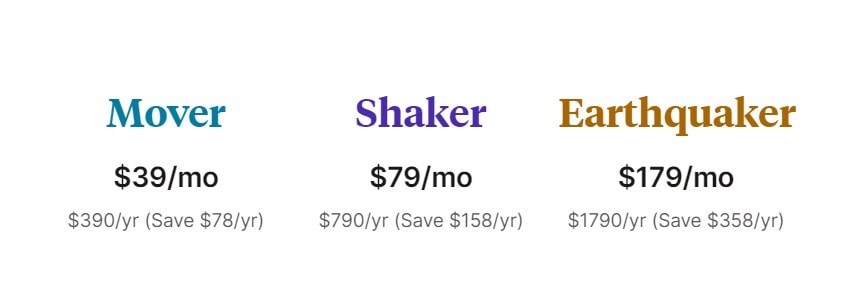
All plans have:
- a 14-day free trial (no credit card required)
- 7-days-a-week support
- unlimited of everything (products, customers, messages, sales, etc.)
- zero transaction fees
- free migrations
- unlimited email subscribers
- custom website
If you have additional teammates, you can add them for $20/month in the Mover and Shaker plan. You have 5 additional teammates included in the Earthquaker plan.
If you want to build a membership site, it’s important to note that you cannot sell memberships in the Mover plan. You can sell only online courses and other digital products. The Mover plan also does not include affiliate marketing.
And while you can add unlimited email subscribers at all plans of Podia, there’s a limit on how many recipients can receive your email in a given month. It’s 5k, 15k, and 50k respectively for Mover, Shaker, and Earthquaker plans. If you want to send emails to more subscribers but stay on the same plan, you can contact Podia for custom pricing.
The highest-tier plan, Earthquaker, includes a dedicated account manager, a white-labeled website, a personalized onboarding call, and a monthly group creator call.
What I love about Podia is how they go out of their way to ensure that you can choose the right plan for your requirements. There’s a video walkthrough to understand which plan is best suited for you. They even do a free weekly demo on Tuesdays at 2 PM ET and send you the replay in your inbox in case you miss it.
You don’t even have to choose a plan in your 14-day free trial. It comes with all the features of the Shaker plan. In the pricing arena, Podia nails it.
Customer Support
This is where Podia shines. Many creators migrate to Podia because of its excellent customer service. They have 7-day-week support and live chat service. I reached out to Podia to find out if I can price my course in different currencies and got a response in under 30 minutes.

I loved the use of emojis in the chat and how quick the response was. While they do not offer phone support, their chat support is pretty thorough. You can also submit a request separately. I see many reviews pointing out that Podia takes recommendations seriously. They didn’t have email personalization earlier but added it when it was requested by many creators.
When I took a look at their Help Center, I could find the response to most of my questions. It is updated regularly, has most of the basic information required, and is easy to find.
In customer support, Podia is 10/10.
Course Creation And Management Inside Podia
Now that you know that the pricing fits your budget and customer support is top-notch, it’s time to evaluate if the course creation tools at Podia are worth the price.
I test whether the platform is too technically driven and thus, hard to use for beginners. I also like when there are multiple engagement tools I can use to keep the students who have enrolled engaged.
Many creators also make their websites on the course building platform itself, so the design must be customizable and modern. Let’s see how Podia fares in all of these tests.
Content Uploading
The content uploading is intuitive and super easy to use. You can drag and drop your content files and add URLs, quizzes, and texts to your course.
The course settings are available at the top which is great to have everything in one place. You can decide to price, see comments and customers, and manage other settings easily. You can also decide the publishing status of your course from here.
On the “Settings” page, you can create categories that your course belongs in. This helps it appear neatly classified on your website.
You can also decide to set an enrollment start date (if you want all your customers to begin at the same time), close enrollment, enable or disable the course’s visibility on your website, and enable or disable comments.
This is also the page where you can integrate a third-party email service provider and choose a social media image for your course. This is the image that would appear whenever your course link is shared on social media.
You can also customize your course link on the “Settings” page itself. Similarly, you can also choose thumbnails for all your video lessons and manage captions that are appearing on them.
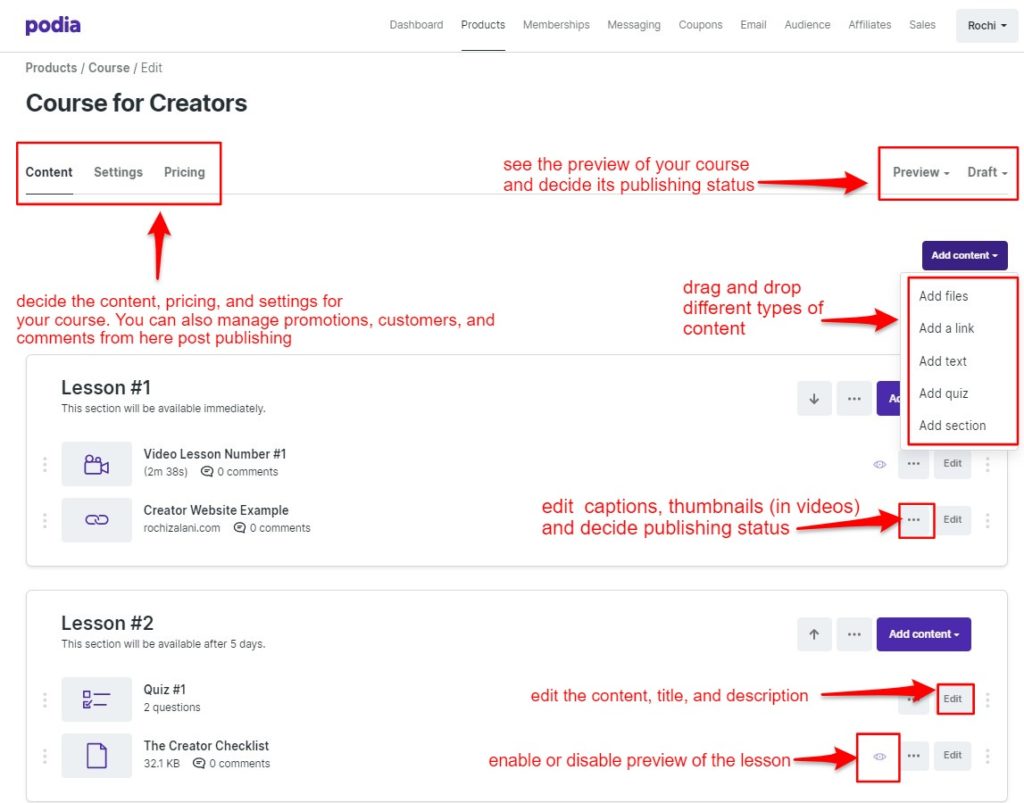
While the content uploading is great at Podia, here are some things that I don’t like:
- You cannot upload your videos from the cloud
- You cannot disable or enable comments for just one lesson/section of the course. It’s all-or-nothing
- The editing options per lesson are limited to basic formatting. For example, you cannot attach a supplementary text to a video lesson
Overall, while Podia would suffice the content uploading needs of most creators, it lacks the advanced functionality its competitors have.
Engagement Tools: Quizzes, Assignments, And The Like
This is the one area where Podia seriously needs to improve. It is my least favorite feature on the platform.
Podia just has the basic quiz feature where you can add questions and one or multiple right answers. That’s it.
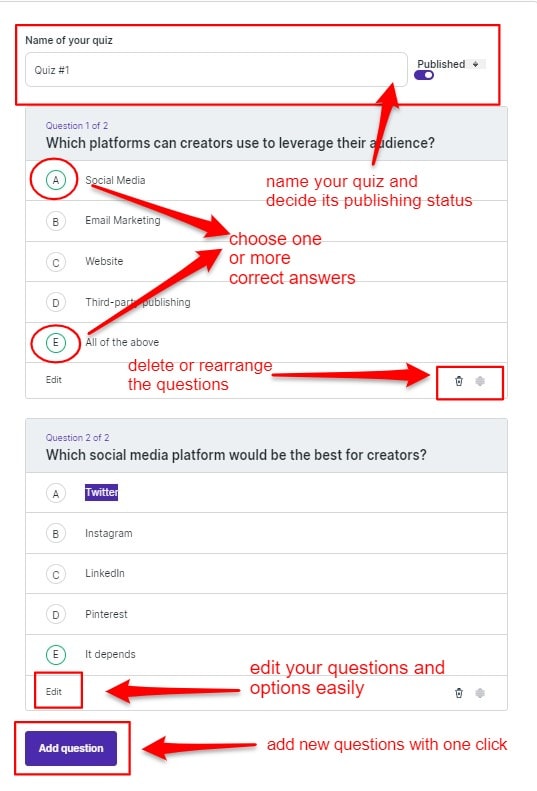
Podia lacks many, many features in engagement – you cannot add assignments, you cannot randomize the questions, you cannot set a passing score, or create an advanced examination environment.
If quizzes and assignments are crucial to your course, Podia may not be the best choice.
Course Player
The course player is where your students spend most of their time. It should be engaging, easy to use, and aesthetic. Podia does not disappoint in this segment.
The design is sleek and minimalistic. Students can easily track their progress, see if a lesson/section is locked, and get the overall gist of the course on their dashboard.
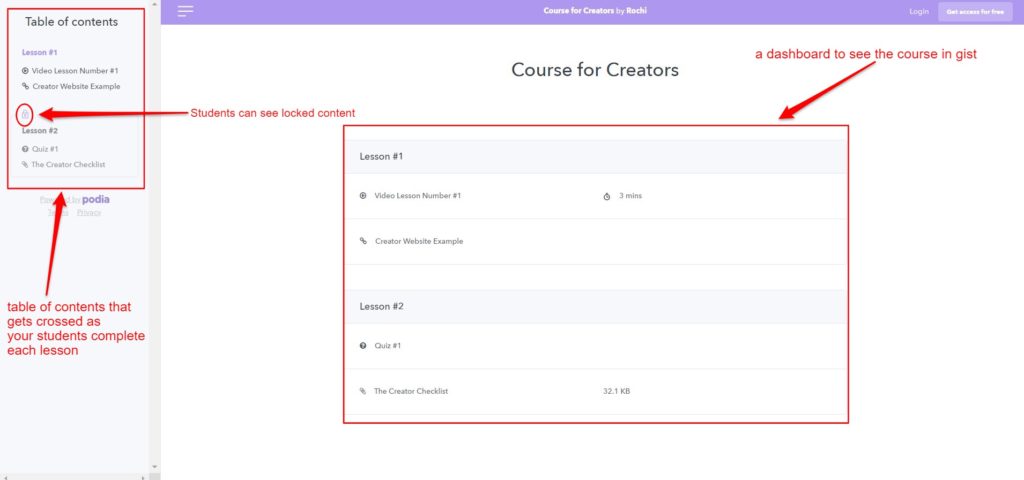
While this course player would suit most creators, it might be “too simple” for some. For example, in our Kajabi review, we saw the course player has 10+ themes! Kajabi also has a mobile application on both iOS and Android. And while Podia claims to be mobile-friendly, it can only be run on mobile browsers since it does not have an app.
If you’re okay with your course design being dead simple and don’t fancy too many options, Podia might be the best choice for you.
Course Site Design Customization
Like Podia’s course player, the site customization is also no-fluff and limited choices at Podia. There are no themes to choose from, but you can customize your website’s color, change fonts, add different sections to your website, and build multiple pages on it too.
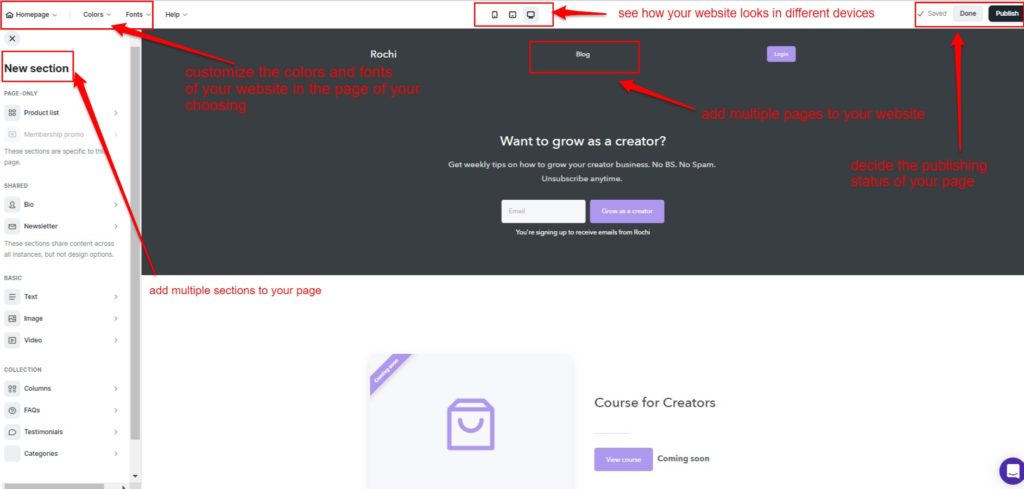
Again, this might be “too simple” for someone who is used to a lot of options and customization. But this might be just enough for someone who sees limited choices and simplicity as a pro. If you want a fancy website, Podia might not be the best choice.
Third-Party Integrations
Podia has a lot of integrations in place to ensure that you have zero hassle in running your online business smoothly.
Although Podia has its own email marketing service, it also integrates with Mailchimp, ConvertKit, AWeber, Drip, ActiveCampaign, MailerLite, and GetResponse. These are some of the top email marketing software in the market. So, if you already use them, you can integrate them easily with Podia.
Along with this, Podia also integrates with Stripe and PayPal so that online payment is easy for your courses. Among analytics, Podia integrates with Google Analytics and HotJar. These are helpful when you want to examine how users are interacting with the sales pages you have created using Podia.
Podia integrates with three advertising tools as well – Facebook, Pinterest, and GoogleAds. These are the three most popular advertising tools, so these integrations might prove truly useful for you.
If something is still missing, Podia also integrates with Zapier, enabling you to integrate with thousands of other apps in the market. Any third-party app that can be installed via a code snippet (like Sumo) can also work in Podia.
Course Marketing And Sales Features
Once the hard part of creating a course, optimizing your website, and running a smooth online business is done, you get to the real business: marketing.
Marketing is crucial to ensure you get more and more enrollments in your courses. Options to stay connected with your audience and make payments easy for them are also important so that you don’t lose customers.
Let’s see how Podia fares in this department.
Email Marketing
Podia allows you to create email broadcasts and email campaigns right from its own platform. This is a huge plus because you don’t have to use another email marketing service or pay for it separately.
The broadcast allows you to add your subscriber’s first name to personalize your email. You can also attach files, choose a later date to send your email, preview your email in your browser, and send a test email to yourself. Overall, it has all the basic features of an email broadcast.
While the basic features would suffice for most online course creators, they might not be enough for someone who is also running a regular newsletter. You can attach files in Podia, but you cannot decide where to place those files (they go as attachments).
There are also certain advanced features in an email marketing service provider like adding boxes, adding line breaks, adding countdown timers, integrating video, etc. that are missing from Podia’s basic broadcast.
The email campaign is top-notch at Podia. You can create an “entrance condition” and an “exit condition” for your email and decide how many days in advance you need to send it. The process is pretty simple to do, even for a beginner who might have never done this before.

Again, while this might suffice for most creators, it is not enough compared to third-party email services. You cannot choose to send emails on specific dates and the “conditions” might be a little tricky to tackle if you have a complex marketing plan.
Product Pricing and Checkout Options
Podia allows you to give away your course for free, ask for a one-time fee, or set up a monthly payment system. It also has membership options, but it’s a separate product (more on that in the upcoming subsections).
You can also offer upsells on the thank you page if you have multiple products at Podia. Apart from this, you can also change the currency your course is priced in. Podia has many currencies on its platform but if yours isn’t there and is supported by Stripe, Podia can add it.
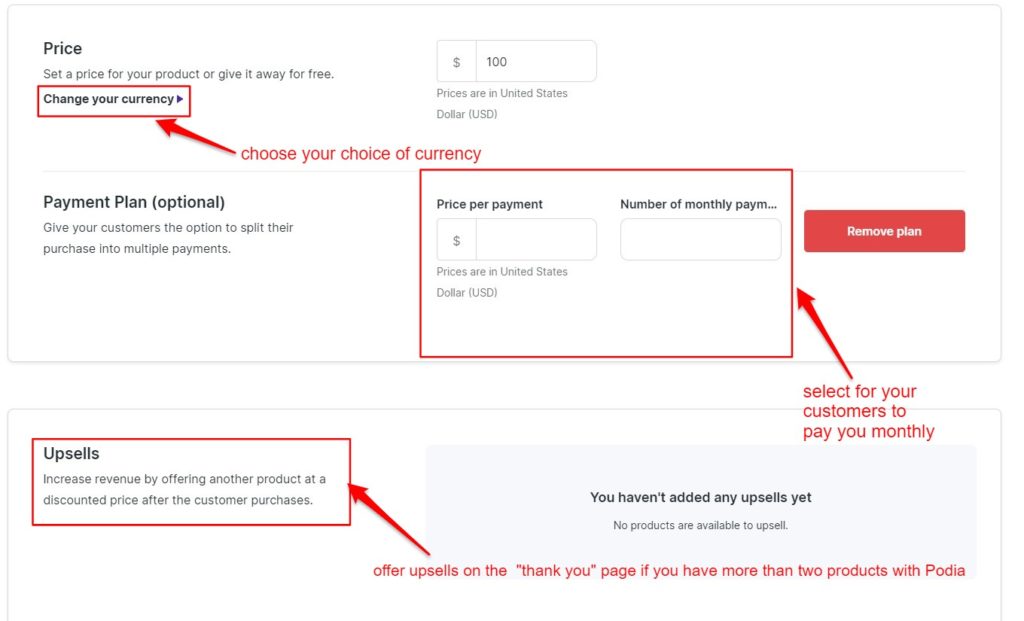
Since Podia has integration with both Stripe and PayPal, your customers can pay easily and you can receive the amount in your bank or PayPal account directly. Podia can also help you collect EU VAT Tax. You can also choose to collect your customers’ addresses for tax purposes or shipping needs.
I love that Podia also has a “Donate” and “Pay what you want” option by using its custom buttons and coupon feature.
What I don’t like about Podia is that the payment process is a tad bit confusing, especially for a beginner. The “Pricing” settings for individual products and your site have a similar name, “Payments,” which can lead to confusion. Apart from this, you also cannot choose to accept payments in two or more currencies.
Affiliate Marketing
The affiliate dashboard at Podia is super simple to use. The overview section can give you an overall gist of all your affiliate earnings, conversion rates, sales, clicks, etc. You can invite an affiliate through their email address easily from the dashboard and also export the list of all your affiliates.
Settings in the affiliate dashboard are the best. You can decide on availability, your default commission, and even have product-specific commissions.
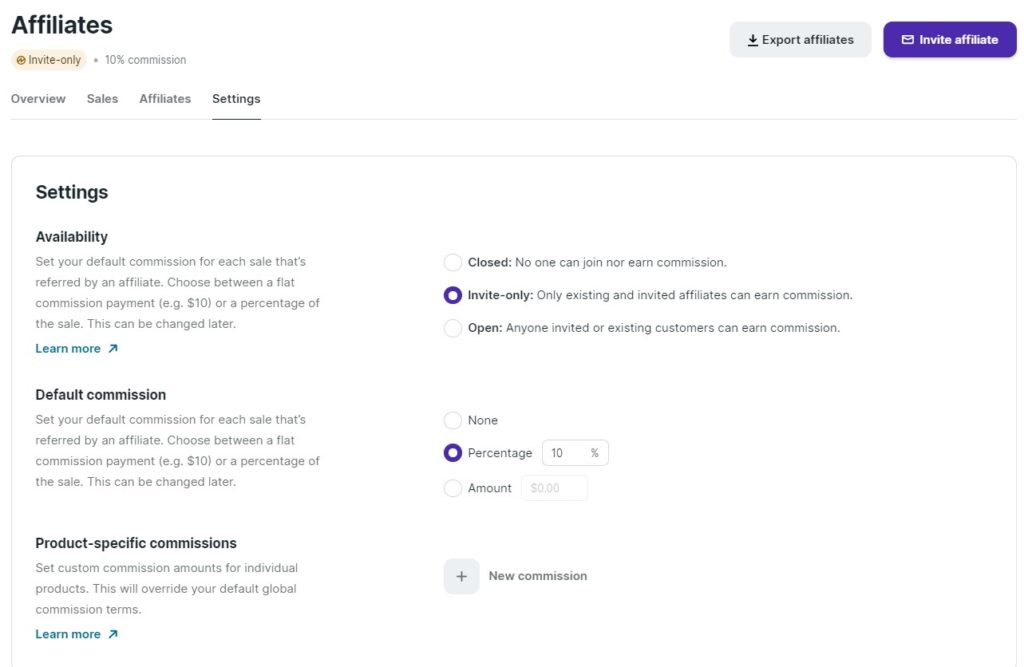
Since Podia has integration with both Stripe and PayPal, your customers can pay easily and you can receive the amount in your bank or PayPal account directly. Podia can also help you collect EU VAT Tax. You can also choose to collect your customers’ addresses for tax purposes or shipping needs.
I love that Podia also has a “Donate” and “Pay what you want” option by using its custom buttons and coupon feature.
What I don’t like about Podia is that the payment process is a tad bit confusing, especially for a beginner. The “Pricing” settings for individual products and your site have a similar name, “Payments,” which can lead to confusion. Apart from this, you also cannot choose to accept payments in two or more currencies.
Affiliate Marketing
The affiliate dashboard at Podia is super simple to use. The overview section can give you an overall gist of all your affiliate earnings, conversion rates, sales, clicks, etc. You can invite an affiliate through their email address easily from the dashboard and also export the list of all your affiliates.
Settings in the affiliate dashboard are the best. You can decide on availability, your default commission, and even have product-specific commissions.

The dashboard allows you to check comments and promote your membership by customizing your social media image, sales page & subscriber page URLs, and embedding a separate button at your own website during checkout.
If you have a Slack channel or a Facebook group, Podia allows you to connect your members through the invite URL as well.
The membership feature at Podia is certainly useful if you want to host your website, your courses, your digital products (more on that in the upcoming section), and your membership all in one place.
Selling Digital Products
You can also sell downloadables and other digital products through Podia. Here too you can either choose to give this for free, set up a monthly payment, or a one-time fee.
You can also choose to upsell when you sell this product by giving a discount for buying one of your other products (courses or memberships) built through Podia. There’s also a setting to decide the availability, visibility, and start date when your digital product will be available. You can see the revenue you have earned from your digital product separately on its dashboard.
Course Reporting And Analytics
This is one of my least favorite features of Podia. Other platforms like Kajabi and Thinkific provide a detailed course analysis on how your course is performing. You can evaluate if students are engaged, how much of your video lessons are they watching, etc.
But in Podia, you can only see an overall gist of your customers and the revenue that it has brought you. That’s it. That’s all the built-in analytics at Podia for your courses and your digital downloads.

The membership reporting looks similar – except that it measures different parameters like total views, comments, top members, etc.
You might need a third-party service provider to integrate with Podia to see better analytics and reporting of your online course.
Podia Alternatives
Podia might work out great for many creators. But if you’re on the verge of deciding and not quite sure about what else is out there, an evaluation of Podia against its competitors will help.
Podia Vs. Thinkific
Thinkific remains one of the most popular platforms for building a course in the market. It’s fairly easy-to-use and the pricing of Podia and Thinkific is competitive. But Thinkific has a free plan available while Podia doesn’t. Apart from this, Thinkific also has better analytics than Podia. And if you’re looking for a platform that has advanced examination features, Thinkific is the way to go. Thinkific does not have email marketing yet, so if you want to have that in one place, stick to Podia.
Podia Vs. Kajabi
Kajabi is a close competitor to Podia because both of them are one-stop solutions to your online business. Kajabi has better analytics and assessments than Podia. You can send multiple products at Kajabi too, although you cannot build the same kind of digital product present at Podia. Kajabi also has a better community feature while Podia lacks any. If the price point is in your budget and you don’t mind a little technical complexity because of additional features, go for Kajabi.
Final Verdict
Podia is a great solution for keeping your entire online business in one place without burning a hole in your pocket. Their recent third pricing plan tier has taken their services up a notch. Podia is great for you if you want to keep things dead simple and avoid too many technicalities. It might not be great for you if you want advanced assessment capabilities and more than a basic reporting of how your online business is running.
I hope this review helped you decide if Podia is the right fit for your requirements. I’d definitely recommend it if you’re a beginner and want things simple!